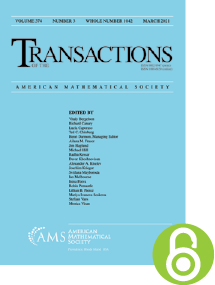Root polytopes, triangulations, and the subdivision algebra. I
HTML articles powered by AMS MathViewer
- by Karola Mészáros PDF
- Trans. Amer. Math. Soc. 363 (2011), 4359-4382 Request permission
Abstract:
The type $A_{n}$ root polytope $\mathcal {P}(A_{n}^+)$ is the convex hull in $\mathbb {R}^{n+1}$ of the origin and the points $e_i-e_j$ for $1\leq i<j \leq n+1$. Given a tree $T$ on the vertex set $[n+1]$, the associated root polytope $\mathcal {P}(T)$ is the intersection of $\mathcal {P}(A_{n}^+)$ with the cone generated by the vectors $e_i-e_j$, where $(i, j) \in E(T)$, $i<j$. The reduced forms of a certain monomial $m[T]$ in commuting variables $x_{ij}$ under the reduction $x_{ij}x_{jk} \rightarrow x_{ik}x_{ij}+x_{jk}x_{ik}+\beta x_{ik}$ can be interpreted as triangulations of $\mathcal {P}(T)$. Using these triangulations, the volume and Ehrhart polynomial of $\mathcal {P}(T)$ are obtained. If we allow variables $x_{ij}$ and $x_{kl}$ to commute only when $i, j, k, l$ are distinct, then the reduced form of $m[T]$ is unique and yields a canonical triangulation of $\mathcal {P}(T)$ in which each simplex corresponds to a noncrossing alternating forest. Most generally, in the noncommutative case, which was introduced in the form of a noncommutative quadratic algebra by Kirillov, the reduced forms of all monomials are unique.References
- Matthias Beck and Sinai Robins, Computing the continuous discretely, Undergraduate Texts in Mathematics, Springer, New York, 2007. Integer-point enumeration in polyhedra. MR 2271992
- A. Cayley, On the partitions of a polygon, Proc. Lond. Math. Soc. 22 (1890), 237-262.
- Sergey Fomin and Anatol N. Kirillov, Quadratic algebras, Dunkl elements, and Schubert calculus, Advances in geometry, Progr. Math., vol. 172, Birkhäuser Boston, Boston, MA, 1999, pp. 147–182. MR 1667680
- W. Fong, Triangulations and Combinatorial Properties of Convex Polytopes, Ph.D. Thesis, 2000.
- Israel M. Gelfand, Mark I. Graev, and Alexander Postnikov, Combinatorics of hypergeometric functions associated with positive roots, The Arnold-Gelfand mathematical seminars, Birkhäuser Boston, Boston, MA, 1997, pp. 205–221. MR 1429893, DOI 10.1007/978-1-4612-4122-5_{1}0
- Edward L. Green, Noncommutative Gröbner bases, and projective resolutions, Computational methods for representations of groups and algebras (Essen, 1997) Progr. Math., vol. 173, Birkhäuser, Basel, 1999, pp. 29–60. MR 1714602
- Takayuki Hibi, Gröbner basis techniques in algebraic combinatorics, Sém. Lothar. Combin. 59 (2007/10), Art. B59a, 22. MR 2465398
- A. N. Kirillov, On some quadratic algebras, L. D. Faddeev’s Seminar on Mathematical Physics, Amer. Math. Soc. Transl. Ser. 2, vol. 201, Amer. Math. Soc., Providence, RI, 2000, pp. 91–113. MR 1772287, DOI 10.1090/trans2/201/07
- A. N. Kirillov, personal communication, 2007.
- Alexander Postnikov, Permutohedra, associahedra, and beyond, Int. Math. Res. Not. IMRN 6 (2009), 1026–1106. MR 2487491, DOI 10.1093/imrn/rnn153
- V. Reiner, Quotients of Coxeter complexes and P-Partitions, Ph.D. Thesis, 1990.
- Victor Reiner, Signed posets, J. Combin. Theory Ser. A 62 (1993), no. 2, 324–360. MR 1207741, DOI 10.1016/0097-3165(93)90052-A
- R. Stanley, Catalan addendum (version of 20 September 2007), http://www-math.mit.edu/ $\sim$rstan/ec/catadd.pdf.
- Richard P. Stanley, Combinatorics and commutative algebra, 2nd ed., Progress in Mathematics, vol. 41, Birkhäuser Boston, Inc., Boston, MA, 1996. MR 1453579
- Richard P. Stanley, Enumerative combinatorics. Vol. 2, Cambridge Studies in Advanced Mathematics, vol. 62, Cambridge University Press, Cambridge, 1999. With a foreword by Gian-Carlo Rota and appendix 1 by Sergey Fomin. MR 1676282, DOI 10.1017/CBO9780511609589
Additional Information
- Karola Mészáros
- Affiliation: Department of Mathematics, Massachusetts Institute of Technology, Cambridge, Massachusetts 02139
- MR Author ID: 823389
- Received by editor(s): October 6, 2009
- Received by editor(s) in revised form: December 7, 2009
- Published electronically: March 16, 2011
- © Copyright 2011
American Mathematical Society
The copyright for this article reverts to public domain 28 years after publication. - Journal: Trans. Amer. Math. Soc. 363 (2011), 4359-4382
- MSC (2010): Primary 05E15, 16S99, 52B11, 52B22, 51M25
- DOI: https://doi.org/10.1090/S0002-9947-2011-05265-7
- MathSciNet review: 2792991


